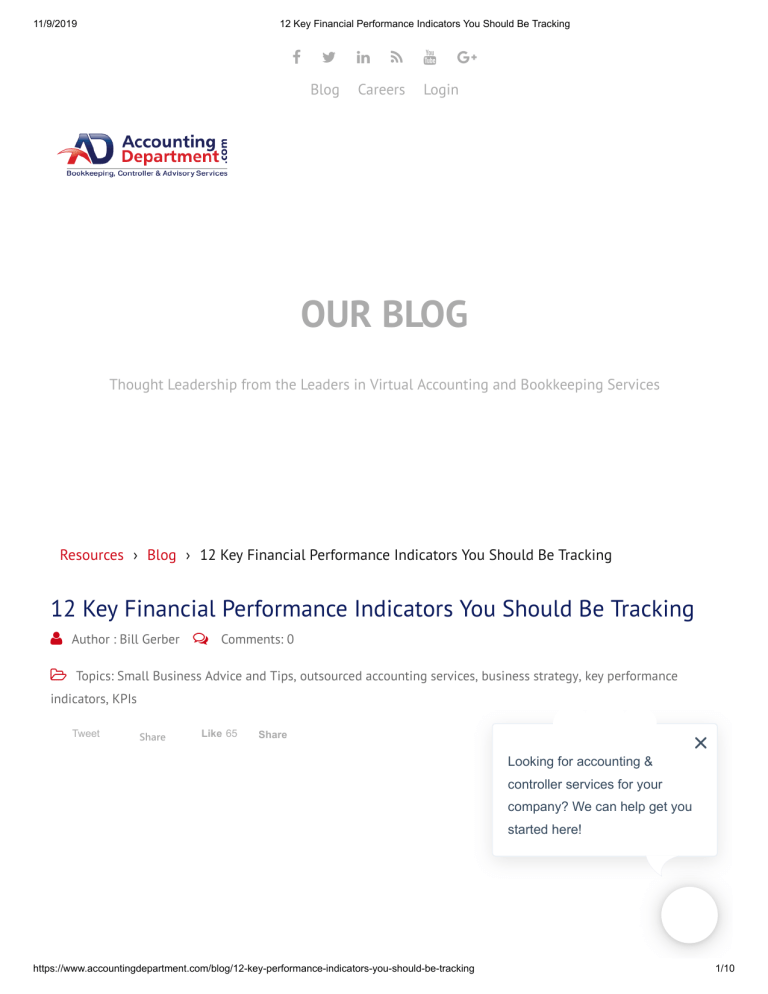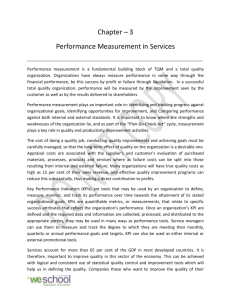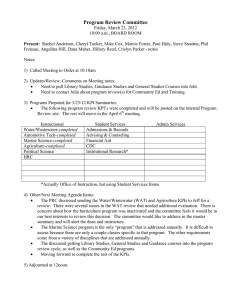
11/9/2019 12 Key Financial Performance Indicators You Should Be Tracking Blog Careers Login OUR BLOG Thought Leadership from the Leaders in Virtual Accounting and Bookkeeping Services Resources › Blog › 12 Key Financial Performance Indicators You Should Be Tracking 12 Key Financial Performance Indicators You Should Be Tracking Author : Bill Gerber Comments: 0 Topics: Small Business Advice and Tips, outsourced accounting services, business strategy, key performance indicators, KPIs Tweet Share Like 65 Share Looking for accounting & controller services for your company? We can help get you started here! https://www.accountingdepartment.com/blog/12-key-performance-indicators-you-should-be-tracking 1/10 11/9/2019 12 Key Financial Performance Indicators You Should Be Tracking Your business's Key Performance Indicators (KPIs) are your tools for measuring and tracking progress in essential areas of company performance. Your KPIs provide you with a general picture of the overall health of your business. Acquiring insights afforded by your KPIs allows you to be proactive in making necessary changes in under-performing areas, preventing potentially serious losses. The KPI quanti cation then allows you to measure the effectiveness of your efforts. This process ensures the long-term sustainability of your company's operating model, and helps increase your business's value as an investment. The rst priority is to identify and understand the overall impact that the various nancial realities represented by your KPI numbers have on your business. Then, use the insights you acquire from these invaluable nancial management performance indicators to identify and implement changes that correct problems with policies, processes, personnel, or products that are impacting one or more of Looking for accounting & your KPI values. controller services for your company? We can help get you Primary KPIs that you're undoubtedly already using include revenue, expense, gross pro t, and net started here! pro t. Here are other key indicators that should be tracked, analyzed, and acted upon as needed. 1. Operating Cash Flow Monitoring and analyzing your Operating Cash Flow is an essential for understanding your ability to pay for deliveries and routine operating expenses. This KPI is also used in comparison with total capital you https://www.accountingdepartment.com/blog/12-key-performance-indicators-you-should-be-tracking 2/10 11/9/2019 12 Key Financial Performance Indicators You Should Be Tracking have in use—an analysis that reveals whether or not your operations are generating suf cient cash for support of capital investments you are making to advance your business. The analysis of your ratio of operating cash ow compared to your total capital employed gives you deeper insight into your business's nancial health, allowing you to look beyond just pro ts, when making capital investment decisions. 2. Working Capital Cash that is immediately available is "working capital". Calculate your Working Capital by subtracting your business's existing liabilities from its existing assets. Cash on hand, accounts receivable, shortterm investments are all included, as well as accounts payable, accrued expenses, and loans are all part of this KPI equation. This especially meaningful KPI informs you of the condition of your business in terms of its available operating funds, by showing the extent to which your available assets can cover your short-term nancial liabilities. 3. Current Ratio While the Working Capital KPI discussed above subtracts liabilities from assets, the Current Ratio KPI divides total assets by liabilities to give you an understanding the solvency of your business—i.e., how well your company is positioned to meet its nancial obligations consistently on time and to maintain a level of credit rating that is required to order to grow and expand your business. 4. Debt to Equity Ratio Debt to Equity is a ratio calculated by looking at your business's total liabilities in contrast to your shareholders' equity (net worth). This KPI indicates how well your business is funding its growth and how well you are utilizing your shareholders' investments. The number indicates how pro table the business is. It tells you and your shareholders how much debt the business has accrued in effort to become pro table. A high debt-to-equity ratio reveals a practice of paying for growth by accumulating debt. This critical KPI helps you focus on your nancial accountability. Looking for accounting & 5. LOB Revenue Vs. Target controller services for your company? We can help get you This KPI compares your revenue for a line of business to your projectedstarted revenue for it. Tracking and here! analyzing discrepancies between the actual revenues and your projections helps you understand how well a particular department is performing nancially. This is one of the two primary factors in the calculation of the Budget Variance KPI—the comparison between projected and actual operating budget totals, which is necessary in order for you to budget more accurately for needs. https://www.accountingdepartment.com/blog/12-key-performance-indicators-you-should-be-tracking 3/10 11/9/2019 12 Key Financial Performance Indicators You Should Be Tracking 6. LOB Expenses Vs. Budget Comparing actual expenses to the budgeted amount produces this KPI. The comparison helps you understand where and how some budgeted spending went off track, so that you can budget more effectively going forward. Expenses vs. Budget is the other primary factor of the Budget Variance KPI. Knowing the amount of variance between the total assumed and total actual ratio of revenues to expenses helps you become an expert on the relationship between your business's operations and nances. 7. Accounts Payable Turnover The Accounts Payable Turnover KPI shows the rate at which your business pays off suppliers. The ratio is the result of dividing the total costs of sales during a period (the costs your company incurred while supplying its goods or services), by your average accounts payable for that period. This is a very informative ratio when compared over multiple periods. A declining accounts payable turnover KPI may indicate that the length of time your company is taking to pay off its suppliers is increasing and that action is required in order to keep your good standing with your vendors, and to enable your business to take advantage of signi cant time-driven discounts from vendors. 8. Accounts Receivable Turnover The accounts receivable turnover KPI re ects the rate at which your business is successfully collecting payments due from your customers. This KPI is calculated by dividing your total sales for a period by your average accounts receivable for that period. This number can serve as an alert that corrections need to be made in managing receivables, in order to bring payment collections within appropriate timeframes. 9. Inventory Turnover Inventory continuously ows in and out of your production and warehousing facilities. It can be hard to visualize the amount of turnover that is actually taking place. The inventory turnover KPI allows you to know how much of your average inventory your company has sold in a period. This KPI is calculated by Looking for accounting & you a dividing sales within a given period by your average inventory in the same period. The KPI gives controller services for your picture of your company's sales strength and production ef ciency. 10. Return on Equity company? We can help get you started here! The Return on Equity (ROE) KPI measures your company's net income in contrast to each unit of shareholder equity (net worth). By comparing your company's net income to its overall wealth, your ROE indicates whether or not your net income is appropriate for your company's size. https://www.accountingdepartment.com/blog/12-key-performance-indicators-you-should-be-tracking 4/10 11/9/2019 12 Key Financial Performance Indicators You Should Be Tracking Regardless of how much your company is currently worth (its net worth), your current net income will determine its probable worth in the future. Therefore, your business's ROE ratio both informs you of the amount of your organization’s pro tability and quanti es its general operational and nancial management ef ciency. An improving, or high ROE clearly indicates to your shareholders that their investments are being optimized to grow the business. 11. Quick Ratio Your Quick Ratio KPI measures your organization's ability to utilize its highly liquid assets to immediately meet your business's short-term nancial responsibilities. This is the measurement of your company’s wealth and nancial exibility. It is understood as a more conservative evaluation of a business's scal health than the Current Ratio, because calculation of the Quick Ratio excludes inventories from assets. This Quick Ratio KPI has the popular nickname of "Acid Test" (after the nitric acid test used in detecting gold). Similarly, the Quick Ratio is a quick and easy way of assessing the wealth and health of your company. If you’ are a new adopter of KPIs, the Quick Ratio KPI is a good approach to getting a quick view of your business’s overall health. 12. Customer Satisfaction While budget-linked KPIs are important, the ultimate indicator of a company's potential for long-term success is in its Customer Satisfaction quanti cation. The Net Promoter Score (NPS) is the result of calculating the various levels of positive response that customers provide on very brief customer satisfaction surveys. The NPS a simple and accurate measurement of likely rates of customer retention (future sales to current customers) across your revenue base, and of potential for generating referral business to grow that base. Additional Key Indicators Certain other KPIs should be tracked in speci c operational areas of nance, marketing, production, purchasing, customer services, and others. For examples: Looking for accounting & Marketing KPIs — Cost Ratio of Customer Acquisition to Lifetime Value, Lifetime Value, Customer controller services for your Acquisition Cost, and others, Customer Pro tability Score, Relative Market Share. company? We can help get you Recurring Revenue Metrics — income and expense areas, such as recurring service contract fees, started here! subscription fees, product maintenance fees, Revenue Growth Rate, Cash Conversion Cycle. Recurring Revenue Overview — include Recurring Revenue Proportion, Recurring Revenue Growth Rate, Recurring Revenue Exit Rate. LOB Ef ciency Measure — Operating Cycle Time (production rate), Capacity Utilization Rate, Process Downtime Level, Human Capital Value Added, Employee Engagement Level, Quality Index. https://www.accountingdepartment.com/blog/12-key-performance-indicators-you-should-be-tracking 5/10 11/9/2019 12 Key Financial Performance Indicators You Should Be Tracking Finance Department — Operational KPIs should also include obscure indicators such as Finance Error Report KPI, Payment Error Rate KPI. And, a variety of indicators in areas of billing and transaction management, collections, and others. KPI failures can occur due to any one of a number of reasons: Usually, the most readily identi able are inef ciencies in planning, or human error. Customizing a KPI without thoroughly vetting it for its actual practical value to the business can lead to problematic results. Such a KPI can distract you and your entire team from focus on true indicators of performance, and send your business in a wrong direction. Misusing KPIs can happen by over-emphasizing the KPI number itself, and under-emphasizing the real-world operational contributors that generate the numbers. This syndrome can lead to unclear business strategies for improving the parts of operations that underlie the numbers. Get to Know Our Implementation Team First Name Last Name Email Website Looking for accounting & Comment controller services for your company? We can help get you started here! https://www.accountingdepartment.com/blog/12-key-performance-indicators-you-should-be-tracking 6/10 11/9/2019 12 Key Financial Performance Indicators You Should Be Tracking protected by reCAPTCHA Privacy - Terms Submit Comment Looking for accounting & controller services for your company? We can help get you started here! Subscribe to Email Updates https://www.accountingdepartment.com/blog/12-key-performance-indicators-you-should-be-tracking 7/10 11/9/2019 12 Key Financial Performance Indicators You Should Be Tracking SUBSCRIBE Topics Accounting Strategies (137) Outsourced Accounting Services (118) Bookkeeping Services (91) Small Business Bookkeeping (82) Outsourced Accounting (74) Small Business Tips (74) Accounting Services (69) Accounting Software (56) Virtual Accounting (50) Accounting Tips (49) Virtual Bookkeeping (37) Small Business Advice And Tips (35) Accounting (35) Improving Sales (31) Accounting Processes (30) Looking for accounting & controller services for your company? We can help get you started here! Virtual Accountants (29) Outsourced Bookkeeping Services (28) https://www.accountingdepartment.com/blog/12-key-performance-indicators-you-should-be-tracking 8/10 11/9/2019 12 Key Financial Performance Indicators You Should Be Tracking Virtual Bookkeepers (28) Small Business (27) Controller Services (24) View All 10 Signs Your Business Is Ready For Outsourced Accounting Services DOWNLOAD AccountingDepartment.com carries professional liability (E&O) Insurance and employee dishonesty coverage. Privacy Policy Contact Info 888.858.9919 Looking for accounting & Info@AccountingDepartment.com company? We can help get you controller services for your started here! Subscribe to our blog SUBSCRIBE https://www.accountingdepartment.com/blog/12-key-performance-indicators-you-should-be-tracking 9/10 11/9/2019 12 Key Financial Performance Indicators You Should Be Tracking © 2019 AccountingDepartment.com, LLC Looking for accounting & controller services for your company? We can help get you started here! https://www.accountingdepartment.com/blog/12-key-performance-indicators-you-should-be-tracking 10/10




